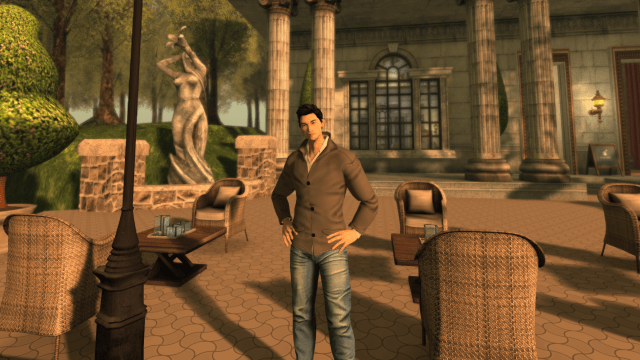Don’t call it a comeback. Second Life has been here for years — 11, this month — but after the virtual world’s much-vaunted debut, the online universe slowly slipped out of the cultural consciousness, now infrequently referenced more as a punchline than legitimate popular hangout. Unless you, like I did last week, have an Oculus Rift handy.
You’d think Second Life is a ghost town by now. And yet! One million people still actively inhabit the digital universe, a number that’s stayed impressively consistent since its early heyday. Over the past decade, those loyal early adopters have created over a petabyte of user-generated content in the form of — well, anything and everything you could possibly dream up: replicas of real-life locations where it’s possible to fly, triple-X adult zones where it’s possible to get filthy, and detailed scenes inhabited by avatars who may or may not resemble their flesh-and-blood counterparts.
Times have changed, however, and as we teeter on the verge of an Oculus Rift-led virtual reality revolution, Second Life’s new CEO Ebbe Altberg felt it was time to “reintroduce” his company to the public, complete with VR-goggle integration.
The timing is auspicious; Altberg has been looking to the next thing lately, which in case means a major new platform that Linden Labs is developing. They’re on a hiring spree now, with plans to add 40 to 50 new team members in the next few months to begin development for a beta launch next year for a second Second Life, an as-yet unnamed digital world is supposed to look better, perform better, and be easier to use than its predecessor.
In the meantime, it’s still early days for Oculus itself as well as the Second Life integration, and last week I visited Linden Lab’s light-filled headquarters in San Francisco to meet Altberg, don a dorky blackout headset, and test out the beta version of this second Second Life. This is what it’s like when virtual existence and virtual reality collide.
Nobody Puts Peter in the Corner
I was familiar with the visual feel of Second Life, but had never actually crossed the threshold or controlled an avatar myself, so this was an adventure for me; albeit one that required no more action on my part than sitting in a small, basement-level conference room and turning my head from side to side.
I wanted to try out creating my own Second Life identity — one of the joys of the experience seems to be finely tuning your head-to-toe look and personal style — but instead was given command of Peter, an average-looking, well-built white guy in a grey cardigan and blue jeans (who happened to be the alter-ego of Peter Grey, director of global communications, who sat in on the demo with Altberg and I). Peter would be my afternoon’s virtual meat puppet.
Our first stop was a luxe colonial mansion projected on a screen for the three of us to see; no Oculus yet, just a standard two-dimensional introduction. I was given control of the keyboard and told to use the arrows to navigate. My Peter moved around the living space (I was the only person in there at the time). It was engaging — look at him go! — but it didn’t necessarily feel real. So I reached for the Oculus Rift. I was ready for total immersion.
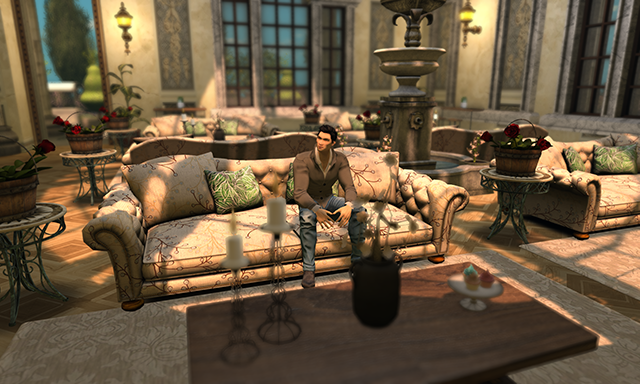
This is a dramatic reenactment that Grey sent me after the fact, with graphics that look a hell of a lot spiffier than what I saw.
Immediately Peter’s point-of-view was my own. Same graphics, new perspective, and still very distinctly Second Life; it was a far (far!) cry from from the verisimilitude offered by the Jaunt camera’s cinematic immersion.
The project viewer control features are limited at the moment I tapped at the arrows on my keyboard and tried to navigate around the sofa, but quickly ended up nudged up against a plant, facing the wall in the corner of the room. I mashed down on the arrows.
“I’m stuck in a corner,” I explained. Altberg and Grey couldn’t see what I see — the scene is no longer being shown on the big screen — so they offered general guidance on how to make my way around while I swiveled in my chair, like this:
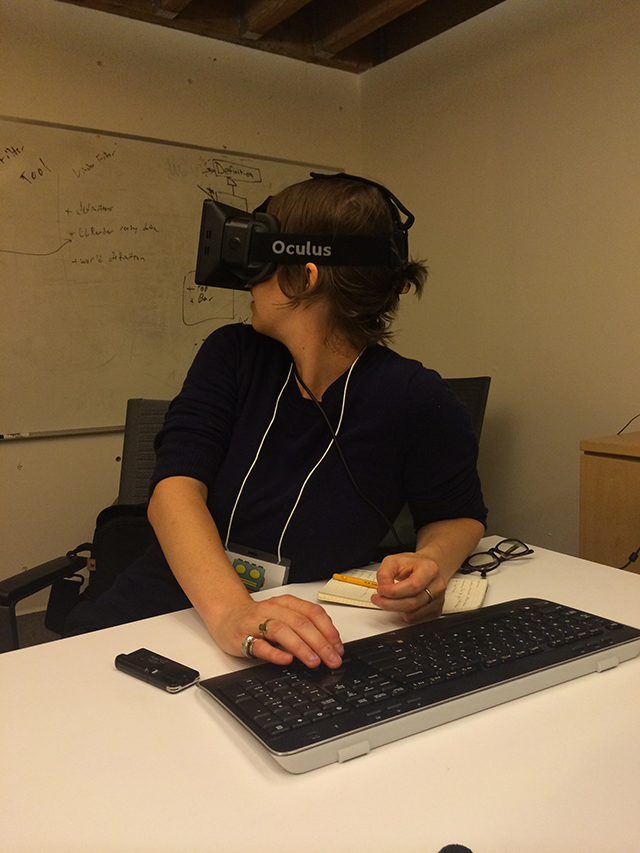
I cannot for the life of me figure out how to escape, and so I take off the headset, and this is immediately shown on the wall.
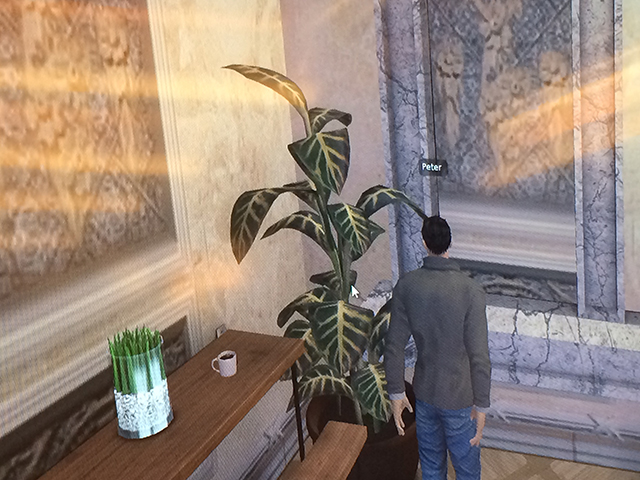
D’oh.
“It’s Getting A Little Dark, So I Turned on the Sun”
Getting trapped in my own virtual living room was a novelty, but not exactly the you-can’t-do-this-in-real-life journey I was hoping for, so we teleported to Mont Saint-Michel. On the actual island in actual France, you have to abide by the laws of gravity (boring). Here, however, I had the ability to take flight. Dusk began to fall, but IRL Peter wanted to continue to the tour so he clicked the mouse and the sky lit up.
“It was getting a little dark so I turned on the sun,” he said. I see a pair of unidentified airborne objects in the distance, so I make my way over. Seagulls? Nope; just a couple of folks hanging out, zipping around each other like hummingbirds. They did not want to talk to me.
I was more comfortable navigating Second Life when it was projected on the screen versus attached to my face; in these early stages of integration the “realness” of the fully immersive experience didn’t feel… well, real.
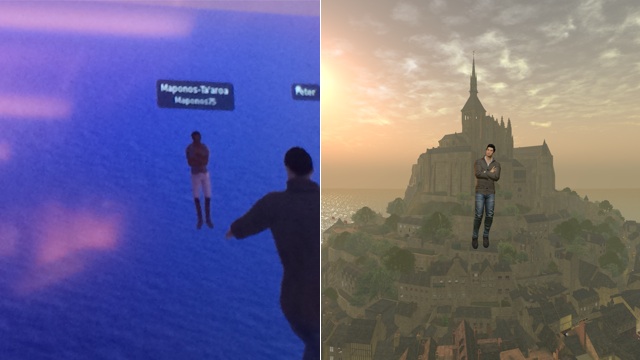
My experience versus Grey’s post-journey pic.
Look Within Yourself
The list of industries, tasks, and past-times getting an Oculus-enabled boost only continues to expand: college tourscar-buying; and next-gen warfare have all gotten the Rift treatment. Adding VR compatibility is a natural extension for Second Life. But for now, the integration is far from smooth.
Though the picture was pretty clear, the lag time to align graphics with my head movements was enough to make me feel nauseous. At one point, swathes of black obscured my vision.
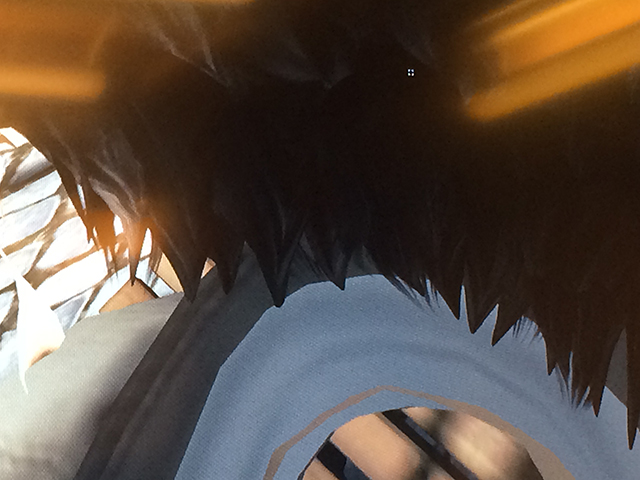
This is what the inside of a Second Life avatar looks like.
“I can’t see anything,” I said, and handed the headset to Altberg, who put it on to see what I was talking about. “Yes, this happens sometimes. You’re actually looking down through your own body.” As intriguing as that Innerspace-style bug could be, attempting to make sense of it while wearing the goggles made my brain hurt.
Also: When you’re wearing something over your eyes that completely obscures your vision, you can’t see the keyboard. When you can’t see the keyboard, you have to be a super solid touch-typist to manipulate your avatar, which requires tapping the arrows and spelling out sentences to chat (if you’re not using vocal commands). It’s obviously not impossible, but there is a fundamental disconnect that seems important to address with a work-around.
While Altberg said that the existing environments will for the most part translate to Oculus, some details will change in the transition; this means that folks who have spent loads of time customising their land might need to take on some renovations.
Though VR might entice newbies into Second Life, the fact that it has been around for so long makes it a tough sell in the fast-paced and fickle realm of internet trends. Will this next iteration appeal to a wider audience? Alienate the acolytes? We’ll see — with a black box strapped firmly to our face, no doubt.
Life After Second Life
Presumably Oculus Rift will be better suited for whatever’s coming next, that new platform Linden Lab has been staffing up for. The goal is to take advantage of the massive advances in social tech and hardware compatibility that have changed the way we live since 2003, and to function across all devices: mobile, tablet, PC, VR.
That being said, they will still be capitalising on the digital-community-building expertise they practically invented in the early aughts. “It will be in the same spirit,” Grey says. “It will be users, not Linden Lab, who create incredible 3D content and experiences that they can then monetise.”
But it will be completely separate from Second Life, at least to start; complete compatibility will not be a requirement. “We don’t want to constrain our development or limit how great the new platform can be by ensuring that everything created over Second Life’s 11-year history will work seamlessly. However, we do plan to allow users to bring over their identity, social connections, and Linden dollars, and we expect that some of the more modern content in Second Life (e.g. meshes) will be transportable as well, although they may require some adjustment.”
All new things do. But hopefully whatever’s coming next — and the virtual reality hardware that helps make it as totally immersive as our dreams — won’t find itself stuck in a corner for long.
